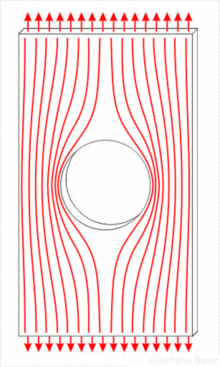
In solid mechanics, a stress concentration (also called a stress raiser or a stress riser or notch sensitivity) is a location in an object where the stress is significantly greater than the surrounding region. Stress concentrations occur when there are irregularities in the geometry or material of a structural component that cause an interruption to the flow of stress. This arises from such details as holes, grooves, notches and fillets. Stress concentrations may also occur from accidental damage such as nicks and scratches.
The degree of concentration of a discontinuity under typically tensile loads can be expressed as a non-dimensional stress concentration factor , which is the ratio of the highest stress to the nominal far field stress. For a circular hole in an infinite plate, .[1] The stress concentration factor should not be confused with the stress intensity factor, which is used to define the effect of a crack on the stresses in the region around a crack tip.[2]
For ductile materials, large loads can cause localised plastic deformation or yielding that will typically occur first at a stress concentration allowing a redistribution of stress and enabling the component to continue to carry load. Brittle materials will typically fail at the stress concentration. However, repeated low level loading may cause a fatigue crack to initiate and slowly grow at a stress concentration leading to the failure of even ductile materials. Fatigue cracks always start at stress raisers, so removing such defects increases the fatigue strength.
- ^ Todd, Greg. "Stress Concentrations at Holes". Fracture Mechanics.
- ^ Schijve, Jaap (2001). Fatigue of Structures and Materials. Springer. p. 90. ISBN 978-0792370147.

